|
Designed
for Smooth Sailing or Rough Seas at Burning Man
by Sally Slevin
|
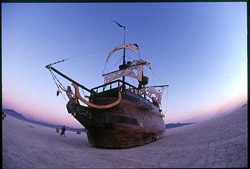 |
Rising out of the Black Rock Desert at Burning Man
appears a 40-foot long Spanish galleon. Without a drop of water
within hundreds of miles and sitting silently on the desert playa,
I’m reminded of a present day scene from “Mad Max”.
Instead of a story about the Road Warrior though,
this is a story of how an engineer designed a half-scale, historically
accurate Spanish galleon so that it could be built in less than
six months.
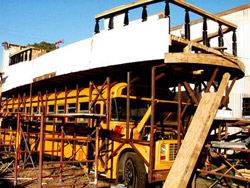 |
And this isn’t just a Spanish
galleon. It’s a Spanish galleon that had to be built onto
an old school bus so that it could be driven around the desert
during Burning Man. Christened La Contessa, the ghost ship was
originally conceived and created by Simon Cheffins, founder
of the Extra
Action Marching Band. For historical accuracy, Simon had
extensively studied galleons that were first built in the 15th
and 16th centuries, mainly used as warships or for exploration
to New Worlds. Some as long as 110 feet and weighing 400 tons,
these large ships could take years to construct. |
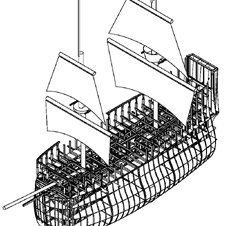 |
Overjoyed at receiving the grant
from Burning Man, the reality of how to accomplish the task
was the first challenge. A reference book on Building Historical
Ship Models provided a guide: typical characteristics, parts,
masts, materials, etc. But this was for a 1/100th scale model
ship; the kind you’d usually find inside a bottle. “I
thought about the execution a lot,” said Simon. “If
I were to get a bus and just build the ship frame around it
in real time it would have been hectic, leading to missed deadlines
and frustrations before finally figuring it out.” Time
and money were pressing issues, as both were scarce. What was
really needed was some technical assistance. That’s when
Greg stepped up. |
Playing trumpet for the Extra Action Marching Band,
Greg Jones also has a day job. As a senior design engineer at E-M
Designs in Half Moon Bay, CA, Greg had worked on numerous large
projects. Welcome to the 21st century.
Greg used Pro/Engineer (Pro/E) v2001 to design the
beautifully curved hull of the ship and deck structure so that sections
could be built simultaneously and accurately, transported and then
easily assembled on site.
| Where to begin? Greg knew the typical
parts needed for the ship: the forecastle or front deck, main
deck, quarterdeck, poop deck and hull. Since the bus had not
been found or purchased, he started with a skeleton of the rectangular
shape of the bus. All the parts referenced the same skeleton.
Instead of building with hard numbers, Greg had to build knowing
things were going to change. “I used a value such as ‘bus
width’,” Greg explained. “Once we got the bus,
I could put in the actual numbers in place and it would regenerate
the model.” |
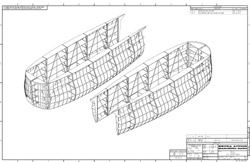 |
| Initially the ship was conceived
as a single-piece permanent structure. The next challenge was
how to move it to the desert? The cost to transport such a wide
load would be prohibitive. Greg considered early in the design
that it would need to be easily taken apart and easily reassembled.
Greg looked at the legal limits for transport on the roads:
an 8’ width and 14’ height. In his usual MacGuyver
style, he designed the deck to keep the middle 8-foot deck sections
together, while allowing the starboard and port sides to come
off. |
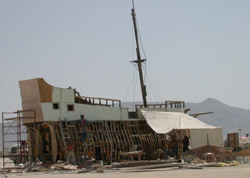 |
Greg did the work in his own time but was able to utilize the resources
at work. “We wanted to support his efforts,” said Mike
Elliott, president of E-M Designs. “Greg’s passion was
infectious. It didn’t take long before he had the other engineers
helping him with documentation and support in their spare time.”
|
All in all, 80 hours of mechanical engineering were spent
before the bus was even acquired. The remaining 20 hours were
used putting in final numbers, making adjustments and doing
the documentation. Having the design work done ahead provided
another distinct, timesaving advantage. “Because we had
drawings, construction of the three main parts—deck section,
hull section and frame section—could be done in parallel,”
said Greg. Part A could be done at the same time as Part B.
“Having concise plans allowed all the volunteers to work
at the same time,” said Simon. A rotation of 55 volunteer
workers, many without prior construction experience, worked
long hours and contributed to the harmonic social level. “Given
our deadline,” Simon concluded, “To get the beautiful
shape of the ship would have been impossible without the CAD
work.” The engineering is “hidden” but it’s
what materializes the artist’s vision.
Then of course there was the steel frame, masts and rigging.
Steve Valdez did the steel fabrication that included the frame
to hold the weight off the bus and the extra axle with four
additional wheels; 13 feet wide made from two steel I-beams
for lateral security. The two masts are 23-foot telephone
poles, each with another 10-foot aluminum flagpole on top
of that
|
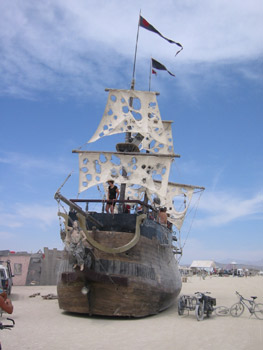
|
Final assembly occurred on site leading up to Burning
Man, the annual event held this year in late August to early September.
While the 40-person marching band played on deck, the Spanish galleon
sailed around the playa every evening occasionally clocking 35mph.
So, what was the reaction? The majority of the over 25,000 people
who attended Burning Man proclaimed La Contessa the “coolest
thing here!” Wasn’t this Simon’s original ethereal
vision of an Old Spanish warship sailing on an ancient, inland sea
that became the Black Rock Desert Playa?
 |
“La Contessa’s gentle curves were achieved with
Pro/E.”
© 2002 Adam Haberlach, http://newsnipple.com.
All rights reserved.
“LaContessa plied the vast expanse of The Floating World”
© 2002 Hovering. All rights reserved.
“Adrift on a dry sea.”
© 2002 Chris Recek, www.members.shaw.ca/eyestroke.
All rights reserved.
“La Contessa riddled with holes.”
© 2002 Andrew Keupper. All rights reserved.
|
|
|
Sally Slevin has more than 20 years of marketing experience
in such areas as software, telecommunications, financial services,
interactive TV and product development. Currently, she is director
of marketing and business development at E-M Designs. Sally’s
articles on technology have been published in Database Trends, AS/400
Technology, CiscoWorld and AS/400 Systems Management. She can be
reached at sally@emdesigns.com.
|









